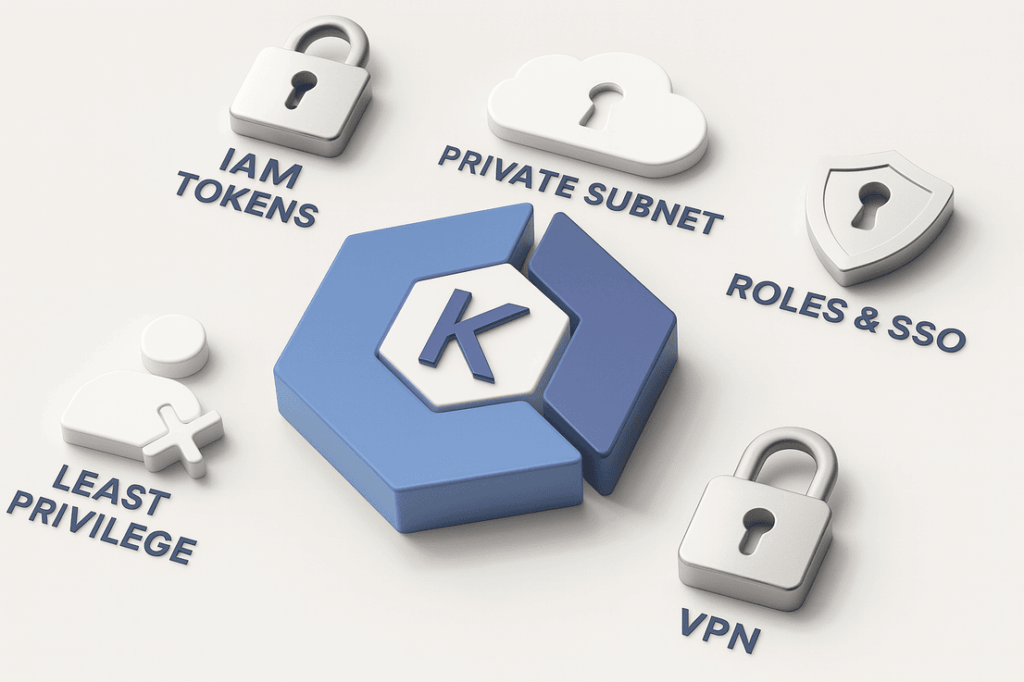For Fintechs handling sensitive data, secrets, transaction records, and API keys, secrets management is not optional. A single leaked secret can compromise an entire application, violate data protection regulations, and destroy trust. This guide outlines five no-fluff, practical techniques to protect secrets on AWS, designed for fast-growing startups aiming for PCI-DSS compliance or preparing for security audits.
1. Use AWS Secrets Manager or SSM Parameter Store (Not Plaintext in Code or ENV)
Hard‑coding credentials in source code, shipping them in Dockerfiles, or injecting them as plain environment variables makes them trivial to leak and nearly impossible to rotate. Instead, store every sensitive value, database passwords, API keys, encryption keys, in AWS Secrets Manager or SSM Parameter Store, where they are encrypted at rest with AWS KMS, version‑controlled, audited via CloudTrail, and retrieved at runtime through IAM‑scoped API calls. This centralised approach keeps secrets out of Git, enables fine‑grained access policies, and lays the groundwork for automated rotation and compliance reporting, all without code changes when credentials inevitably change.
Why it matters: Hardcoding secrets in.env config files or deployment pipelines is dangerous. These files often get pushed to Git or leaked in logs.
What to do:
- Use AWS Secrets Manager for high-security credentials like database passwords, third-party API keys, and Stripe secrets.
- Use AWS Systems Manager Parameter Store for application config and environment-specific tokens.
Key Takeaway: Always keep secrets external to your codebase and centrally managed in AWS with encryption at rest.
2. Rotate Secrets Automatically
Rotating secrets automatically means updating credentials like database passwords, API keys, or tokens on a regular schedule without manual intervention. In AWS, Secrets Manager supports automatic rotation for services such as RDS by integrating with AWS Lambda to handle the rotation logic. This reduces the risk of long-lived secrets being exposed or abused. Fintechs can set rotation intervals (e.g., every 30 days), monitor failures with CloudWatch alarms, and ensure new credentials are injected into apps securely via IAM roles or runtime retrieval. Automating this process enhances security posture and aligns with compliance standards like PCI-DSS.
Why it matters: Static secrets become attack vectors the longer they live. Many cloud breaches exploit long-lived credentials.
What to do:
- Enable automatic rotation in AWS Secrets Manager for supported services (e.g., RDS, Aurora, Redshift).
- Use Lambda rotation functions for custom secrets.
- Set up CloudWatch alarms for rotation failures.
Key Takeaway: Rotate secrets every 30–90 days to limit blast radius in the event of a compromise.
3. Apply Fine-Grained IAM Policies to Secrets
Applying fine-grained IAM policies to secrets ensures that only the right services, applications, or users can access specific secrets under well-defined conditions. Instead of giving broad secretsmanager:* permissions, use resource-specific policies combined with Condition keys like environment tags, service names, or request contexts. This lets you enforce rules like “only the billing microservice in production can access this RDS password,” reducing risk and enabling audit-friendly least privilege access. Pair this with CloudTrail logs and IAM Access Analyzer to continuously review who has access to which secrets and why.
Why it matters: The most common misconfiguration in AWS is overly permissive IAM roles.
What to do:
- Define IAM policies using
Conditionblocks to scope access to secrets by environment or app tag. - Use resource-based policies for extra control.
- Enable CloudTrail logging and Access Analyzer to audit who can access which secrets.
{
"Version": "2012-10-17",
"Statement": [
{
"Effect": "Allow",
"Action": "secretsmanager:GetSecretValue",
"Resource": "arn:aws:secretsmanager:region:account-id:secret:prod/*",
"Condition": {
"StringEquals": { "aws:RequestTag/App": "billing-api" }
}
}
]
}
Key Takeaway: Least privilege is not a guideline—it’s the foundation of fintech security.
4. Encrypt All Secrets with AWS KMS
Encrypting all secrets with AWS Key Management Service (KMS) ensures that sensitive data is protected at rest using strong, auditable encryption. While AWS Secrets Manager and Parameter Store automatically encrypt data using KMS, you can enhance security by using customer-managed keys (CMKs) instead of default AWS-managed ones. CMKs allow you to define who can use the key, enable key rotation, and apply granular access policies. For compliance with standards like PCI-DSS, GDPR, and NDPR, this level of control is critical—it ensures that encryption isn’t just happening, but that it’s being governed and enforced according to your organization’s security posture.
Why it matters: Compliance frameworks like PCI-DSS and NDPR (Nigeria Data Protection Regulation) require strong encryption for all sensitive data.
What to do:
- Use customer-managed KMS keys (CMKs) instead of default AWS-managed keys.
- Rotate your KMS keys annually or semi-annually.
- Enable key policies that restrict usage to specific IAM roles or services.
Key Takeaway: Encryption is only as strong as your key management. Take ownership of your keys.
5. Avoid Passing Secrets in User Data Scripts or CI/CD Pipelines
Injecting secrets directly into EC2 user‑data scripts, Docker build arguments, or CI/CD environment variables risks accidental exposure through logs, image layers, or pipeline artifacts and leaves you scrambling when credentials inevitably change. Instead, retrieve secrets at runtime using IAM roles, such as IRSA for EKS, task roles for ECS, or instance profiles for EC2, so containers and servers pull the latest encrypted values from Secrets Manager or Parameter Store only when needed. This keeps credentials out of code and build systems, enables painless rotation, and dramatically shrinks your attack surface while maintaining compliance.
Why it matters: Many teams inject secrets into EC2 user_data, build containers with secrets in Dockerfiles, or store them in CI/CD variables unencrypted.
What to do:
- Mount secrets at runtime using SSM Agent, Secrets Manager SDK, or ECS Task IAM roles.
- For Kubernetes (EKS), use the external-secrets operator or IRSA (IAM Roles for Service Accounts) to mount secrets securely.
Key Takeaway: Secrets should be injected at runtime, not baked into the infrastructure.
Final Thoughts
Fintechs are under more scrutiny than ever—from regulators, investors, and users. Securing secrets isn’t just about best practice—it’s about protecting user trust and enabling safe scale. By defaulting to managed tools like Secrets Manager, using least-privilege IAM, and rotating secrets routinely, startups can meet compliance goals and sleep better at night.







